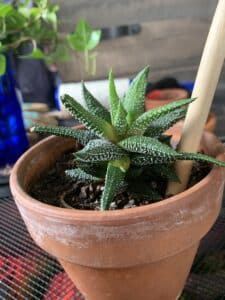For an average person, Haworthia plant (huh·wur·thee·uh) and Aloe Vera plants may not be distinguishable, but they are different for plant enthusiasts like you and me.
Haworthia is a group of succulents that are native to South Africa. Their foliage is impressive, and they produce inflorescence in the name of a flower.
Generally, Haworthia flowers are white and grow on a stalk that can be up to ten times the size of the plant. They bloom during summer if you treat them right. Additionally, Haworthia will take at least 2-3 years to bloom.

Haworthia, known as the zebra cactus, is usually grown for its beautiful foliage resembling zebra stripes.
They have tiny leaves and can form clusters sometimes, but their flowering stems are what make them famous.
Read further below to know how to get this plant to bloom and take care of the flower stem.
Table of Contents
How Often does the Haworthia Flower?
Haworthias are small succulent plants with pretty patterns in the leaves. It has other common names like ‘Pearl plant’ and ‘Star Window plant.’
The plant produces flowers yearly if the growing conditions are up to the mark.
There are varieties of Haworthia plants that can grow in climates with frequent and sporadic rainfall.
This implies that various Haworthia varieties will bloom at different times. They usually bloom during spring or autumn.
Haworthia needs to be mature before it can flower, and as slow-growing plants, they usually take about 2-3 years to mature.

The blooms are perennial, meaning they will return yearly during their growing season.
Flowers of succulents like Haworthia have a varied lifespan and can last from several weeks to months.
Haworthia flower lasts for a few days, but the bract will stand for 6-8 weeks.
In addition, the Haworthia is not monocarpic; it does not die after flowering.
The flower in Haworthia is a direct sign that it is happy with the care you provide, so you may as well let it bloom.
Although it prefers outdoor conditions, Haworthia won’t have a problem blooming indoors if you properly care for the plant.
To add a cherry on top, Haworthia is one of the easiest plants to care for houseplant lovers.
Haworthia Flower Overview
Being succulent, Haworthia plants can survive extended periods of drought conditions. That can span up to months!
Rightly so, they share the similarity with Aloe vera, as both plants belong to the same sub-family.

Let’s look at the basic overview of the Haworthia flower.
| Structure | Long bract with flowers at the top of the bract Long and skinny stem |
| Size | ~16 inches long |
| Color | White |
| Fragrance | Mild unnoticeable smell |
| Toxicity | Non-toxic |
| Lifespan | Few days |
| Seeds | Small irregular shaped black seeds |
| Blooming Season | Summer |
Although the shape and pattern of leaves may vary with the variety of Haworthia, the inflorescence pattern is usually the same with a long stalk.
You can find Haworthia flower seeds on the dried-up seed pods that take up to six months to germinate after their harvest.
Pollination of Haworthia Flowers
When you look at the not-so-attractive Haworthia blooms, the thought of pollinating them comes into your mind.
Grown for the intriguing foliage, Haworthia flowers are less charming than the pearl-patterned leaves.
The Haworthia flowers cannot self-pollinate. You need to collect the pollen from the male part and apply them to the female part.

Haworthias can pollinate naturally but are specific about the pollinators.
According to PSU.EDU, Haworthia is pollinated only by gnats and other small bugs while they are in the wild.
Gnats are more active during the daytime and dusk, resulting in more pollination.
Hand Pollination in Haworthia
Hand pollination is not that hard in Haworthia if you know the basics. Gather tweezers to collect the pollen and sterilize them.
To go on with hand pollination, you must collect the pollen from the flower on its first opening day. You can wait for the anthers to mature and get pollens on the second day.

Follow the steps below to ensure successful pollination.
- If you see the petals curl outside, you can use the pollen as the flower is fully open.
- Go on with the pollination in the afternoon. Remove all the petals from the male and female parts.
- You need to remove the stamens of the female flower and keep them for later use.
- Take 1-2 stamen from the male parent and rub the anthers on the stigma until the pollen can be seen on it.
- Repeat this process for two days to have a greater chance of pollination.
- After nearly a week, if you see the ovary turn green and swollen, congratulations, the pollination was successful.
For better pollination result, choose a male flower that has just opened to cross with a female parent that has opened a few days earlier.
How to Make a Haworthia Plant Bloom?
Haworthia flower may not be so hard to pollinate, but to reach that stage, you need to grow yourself a flower first.
Although Haworthia is not that hard to grow, you will need to fulfill specific care requirements to make them bloom.
Look below for the optimum conditions to make Haworthia bloom.
- Succulents need a lot of energy to be able to produce flowers. So, keep your plant in the morning sun for half a day to let it bloom.
- Ensure your plant has enough moisture during summer and dry air during the winter.
- Water your Haworthia only when the top 1-2 inches of soil is dry. Be on the watch for root rot.
- Fertilize the plant with flower-inducing fertilizer rich in phosphorus during its growing months of spring and summer.
- Maintain the temperature from 75-90°F but do not let the temperature drop below 40°F. Bring the plant inside in cold temperatures.

- Use an organic cactus mix with good drainage and at least 30% pumice or perlite. You can also resort to bone meal for quick success.
- A clay container that will allow too much moisture to escape is best for letting the plant bloom.
- You can move the plant outdoors during summer and keep them in the shade of a tree or a patio.
Sometimes the flower stalks may limp down because they may not handle their weight. In such occurrences, you can stake the stem to hold them up.
What Should you do with Haworthia Flowers?
If you witness the blooming of Haworthia flowers, you can consider yourself lucky and be proud.
Flowering in Haworthia shows that it is happy with the care you have given to the plant. But the reward is not up to the mark.

Whether to remove the white flowers or not entirely depends on your decision. Let’s look at why you should remove them.
- The flowers are not precisely showy and add nothing to the already pleasing look of the plant.
- Haworthia blooms take up the energy directed to the foliage; thus, the foliage can suffer consequences.
- If you are allergic to pollen, it is better to remove the flower before the male part develops.
But keeping the flowers intact also has its benefits. First, you won’t disturb the biology of the plant by letting it bloom.
Second, you will want to keep the flowers in case you want seeds for future germination.
If you leave the flowers as they are, they will eventually wilt down and die.
How to Trim Haworthia Flower?
Your decision to trim the flower off may benefit the plant in the long run. By doing that, you would at least save nutrients.
Follow the steps below to ensure you cut the bloom off the plant properly.
- Early morning is the best time to cut the flower off the plant as the plant is fresh and full of moisture.
- Get pruning shears and all other gardening gears for the trimming process.
- Hold the stalk gently and cut a few centimeters above the point from which it emerged.
- Here is a fun thing to do: Grab hold of the stalk and pull it off the plant with your hand. Try it; it is so satisfying.
- The pulling off is like deadheading the flower. You may not see the flower bloom again in this growing season.
- Follow the above steps correctly and do not damage the surrounding stems and leaves.
There are not any known uses of the Haworthia flower.
Health Considerations to Keep in Mind
Grown for its exotically beautiful foliage, Haworthia doesn’t pose any serious threat to you or your pets.
According to ASPCA, Haworthia and its varieties are entirely non-toxic to dogs and cats.

So you get to keep this beautiful plant in your house and your pets and kids completely risk-free.
If the plant is not toxic, the blooms it produces may be completely non-toxic as well.
But still, if you have a pollen allergy, you would want to stay away from this plant.
Also, keep the following things in mind to be safe.
- Your children and pets could hurt themselves if they play with this plant and accidentally trip the container.
- There is always a risk of your pets and kids choking on the leaves of this plant.
- If you have recently fertilized the plant, it is safe for your kids and pets to stay away from this plant.
Immediately call your local doctor in case your kids get any plant-related injuries.
For pets, call Call ASPCA at 1 (888) 426-4435.
Conclusion
Haworthia may not have pretty blooms, but the silvery-pearl lining on the foliage makes up for it.
You can still rely on your plant to boost the aesthetic charm of your house with intriguing foliage.
Good luck with your Haworthia flower!
You may want to find out more about Haworthia. Please read our article on Haworthia Obtusa and Orange Succulents
